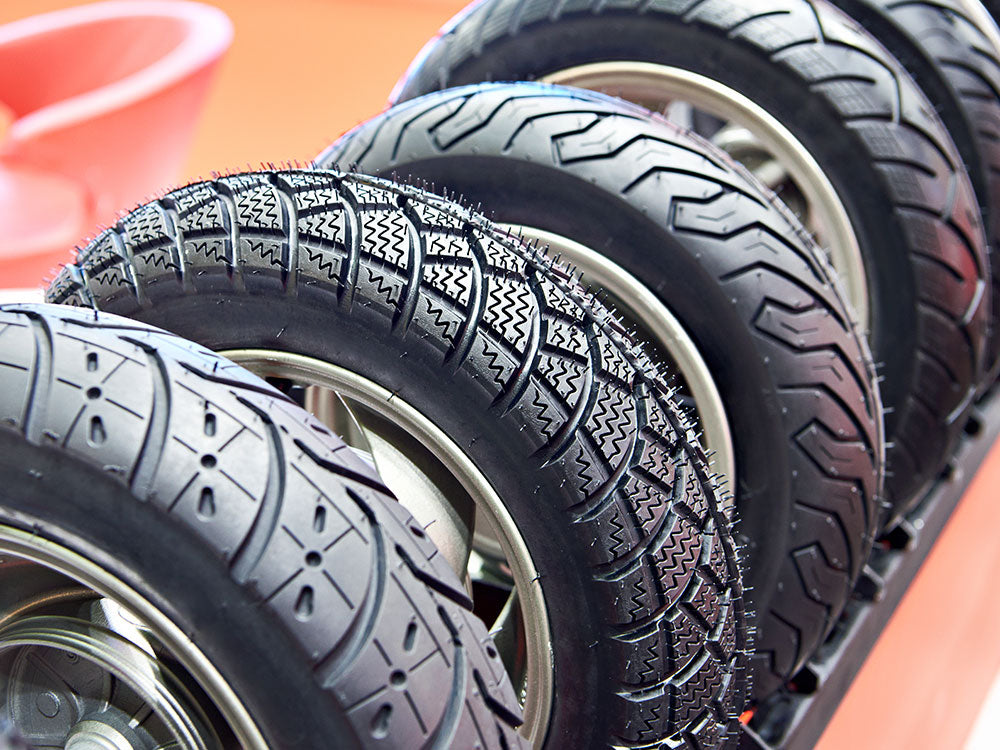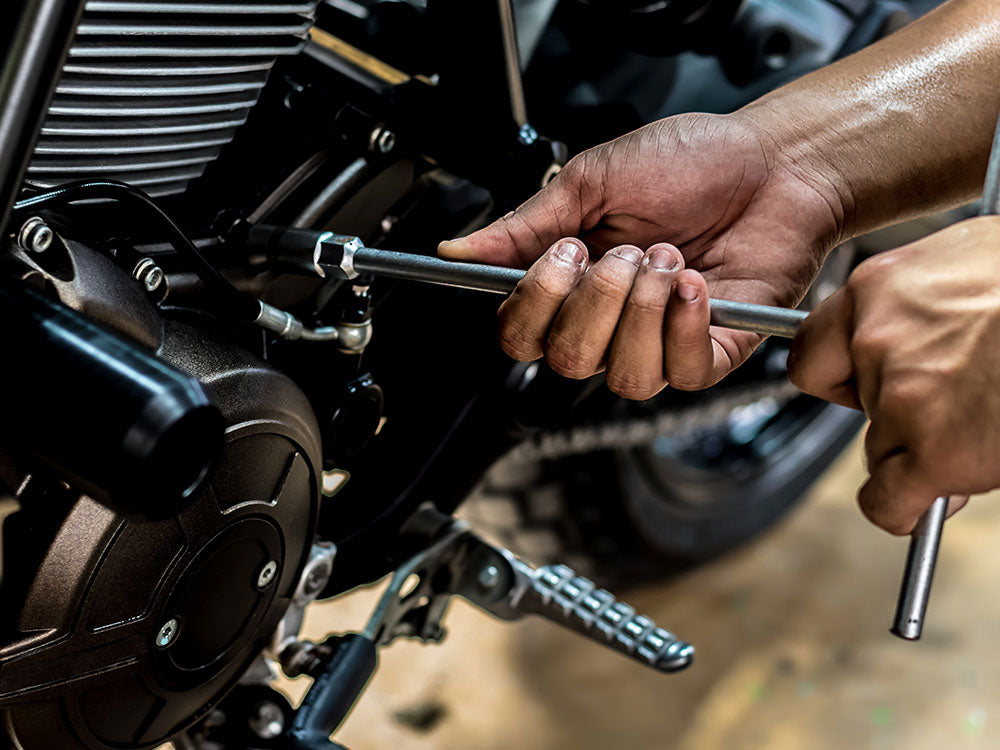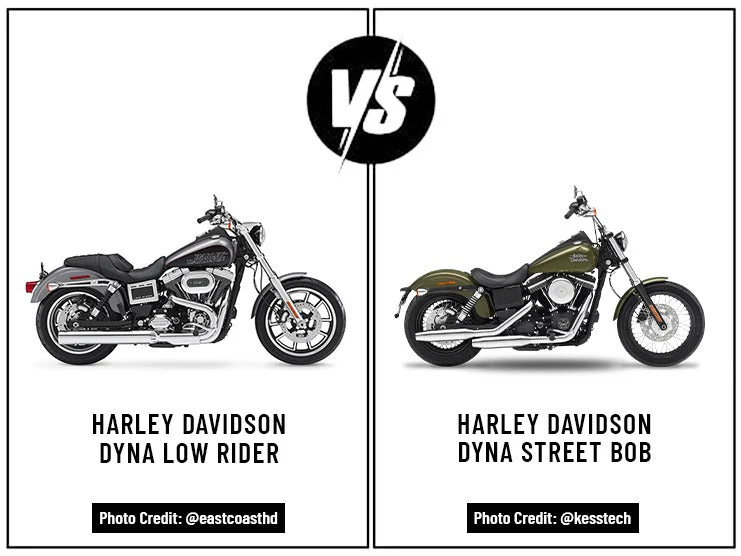Table of Content
1. Introduction
Motorcycle tires are the parts that allow two-wheelers to travel on any surface, keep the bottom of the frame from scraping against the ground, and help reduce the weight of the rider exerting on the motorcycle. Though not having a complex design, motorcycle tires are essential to ensuring a safe riding experience. It is easy to take motorcycle tires for granted when our motorcycle operates as it should. However, riders quickly take notice of motorcycle tires when they become worn out.
The most common issue with motorcycle tires is becoming flat, which often can be fixed with an air pump and adhesive patches. Unfortunately, there comes a point when your motorcycle tires become too damaged or old to be considered usable. When that happens, you will have to find, purchase, and install fresh tires on your vehicle for it to be street-legal again.
Though having to replace your motorcycle tires is part of the life of a motorcyclist, you may not have known that some motorcycle tires have a faulty design that causes them to wear out faster than others. There are also ways that you can ensure that your motorcycle tires last longer than they should. But you first need to understand the reasons why certain motorcycle tires last longer than others.
2. Design & Lifespan of Motorcycle Tires

All motorcycle tires have a perfectly circular structure composed of several layers of rubber compounds. The rubber compounds in the interior determine longevity, while the ones along the exterior help provide traction. All the rubber compounds together help give the tires a rigid structure when inflated, ensure flexibility whenever the motorcycle is leaning, and provide durability against sharp objects. The treads along the circumference ensure better grip whether traveling over dry, wet, smooth, or uneven terrain. Designed with a U-shaped profile, the surface of the tires can change size and shape when pressure is exerted to ensure they remain in contact with the road.
Depending on the brand, the number of rubber compound layers in the motorcycle tires will differ. Typically, the more rubber compound layers fitted within the design that does not significantly increase the weight or reduce flexibility, the longer the motorcycle tires will last.
On average, motorcycle tires should be able to last at least 3,000 to 15,000 miles before they need to be replaced. Also, never continue to ride with motorcycle tires that are at least five years old or above, regardless of how often you ride your two-wheeler.
Unfortunately, the expected mileage you can get out of your motorcycle tires can be significantly lower or higher than this range based on how often you handle your ride, how aggressive your riding style is, and what type of vehicle you own.
If you only take out your motorcycle every once in a while, you might ensure the tires last to the end of the five-year lifespan. If you rely on your motorcycle regularly as a means of transportation, you should expect the tires to wear down a lot faster.
If you prefer to ride your vehicle more casually, then tires on standard motorcycles should last between 10,000 to 15,000 miles. If you tend to ride your vehicle interchangeably between casual and aggressive, then tires on standard motorcycles should last between 5,000 to 10,000 miles. If you often ride your vehicle aggressively then tires on standard motorcycles should last between 3,000 to 5,000 miles.
Keep in mind that these projected mileage ranges are not set values and are subject to change.
Also Read: Choosing the Right Tires For Your Motorcycle
3. Understanding Motorcycle Tire Numbers
The best way to evaluate the quality of your motorcycle tires is by checking the numbers and letters circling along the tire wall.
- When picking out motorcycle tires, check that there is an “M” printed somewhere on the tire wall. This indicates the tires were designed specifically for fitment on motorcycles.
- The first four numbers are the week and year the tire was manufactured.
- The fifth number is the width of the motorcycle tire measured in millimeters.
- The sixth number is the aspect ratio or the tire’s height relative to its width measured as a percentage.
- The seventh number is the rim size or overall circumference of the tire measured in inches.
- The alphanumerical is the type of tire and appropriate rim size.
- The eighth number is the load index or the maximum weight that the tire can handle.
- The capital letter is the speed rating or the maximum speed that the tire can handle.
Besides making sure the specifications of the tires fit with the type of motorcycle you own, try to pick motorcycle tires that are still relatively new and closer to the present. If you pick motorcycle tires that have seen previous use, inspect them to see if there are any signs of damage. Depending on how often and why you ride your motorcycle yearly, you will want tires best suited to your vehicle’s build to ensure you get the most out of them.
Also Read: New Tires – Radial vs. Bias Ply
4. Factors that Shorten Motorcycle Tire Lifespan
Even when your motorcycle is not in use, you must provide regular maintenance for the motorcycle tires to ensure they stay in good condition. Failure to take proper care of your motorcycle’s tires when parked and riding will cause them to be more susceptible to damage and wear out faster. Before you store your ride or scan the road ahead, make sure that it is clear of any possible hazards that could affect the tires. The following factors can potentially shorten the longevity of your motorcycle tires:
4.1 High Temperatures:
The heat generated by friction between the wheels and the road or humid weather conditions that cause an increase in air temperature can cause the rubber compound layers to harden. The fluctuations in temperature will cause the integrity of the tire walls to weaken due to constantly hardening and softening.
4.2 Intense Light:
Being shined upon by the sun’s intense ultraviolet rays cause the rubber material in the tires to gradually weaken and break down. Due to the sun’s rays causing the temperature around and inside the tires to heat up, they contribute to the structural integrity of the tire walls becoming weakened.
4.3 Exposure to Oxygen & Ozone:
Large quantities of oxygen being pumped into the tires when they are being refilled can result in oxidation, which can cause the rubber to solidify unevenly, which ruins the structural integrity of the tire walls. Traces of ozone created due to heat and intense light within the tires causes the rubber layers to decay.
4.4 Physical Stress:
If extra weight is placed on your motorcycle, whether it be luggage, add-ons, etc., the burden would be placed on the tires. The tires being forced to carry beyond their maximum weight capacity will cause their walls to slowly deteriorate. Plus, the tires being pressed even further against the road will cause an increase in friction while riding.
4.5 Aggressive Riding Style:
If you ride at intense speed, turn sharply around corners, or accelerate when riding uphill, the tires have to spin rapidly to keep up with the high output of horsepower and torque. The tires constantly being worked with ferocity causes the treads to weather and lose traction.
4.6 Rough Road Conditions:
Riding over uneven terrain with potholes, jagged points, and bumps can puncture the tire walls or cause the road to impact with the rims. Rough surfaces can gradually crack the rubber exterior, slowly chipping away until the seal breaks and the air begins to escape.
5. How to Extend Motorcycle Tire Lifespan
While it can be difficult to avoid hazards that could be detrimental to the state of your motorcycle tires, adjusting your riding habits and taking necessary precautions can make all the difference. Before you mount your motorcycle, are on the road, or leave your ride parked, take some time to evaluate your motorcycle tires and surroundings to see if you can make conditions better. The following tips are ways you can extend the lifespan of your motorcycle tires:
5.1 Cool Spaces:
Whenever your motorcycle is not in use, try to leave it in an enclosed space like a garage where little to no sunlight can get in and the air temperature remains relatively cool. If you have to park your motorcycle outside, try to find a parking space underneath some shade, whether a building or a tree.
5.2 Wrap in Plastic Bags
To provide protective covering from sunlight or oxygen, wrap the motorcycle tires completely in plastic bags. Make sure the plastic bags are as airtight as possible to reduce the amount of oxygen getting inside the tires. Also, the plastic bags should reflect or keep intense ultraviolet rays from touching the exterior of the motorcycle tires.
5.3 Adjust Tire Pressure
If you are a heavyweight rider and plan to carry a lot of cargo in saddlebags, you will need to pump extra air into the tires to handle the additional weight. Make sure the tire pressure is enough that there is still enough traction and a decent buffer space between the rim and the road.
5.4 Carry Less Weight
Try to travel light and carry only what you need. The less weight being exerted on the motorcycle tires, the larger the buffer space between the tires and rims. Also, if the motorcycle tires are not pressed against the road, then less friction will be generated.
5.5 Apply Brakes & Throttle Gently
Try to keep an eye out for any hazards or stopped vehicles, then gradually apply the brakes until your motorcycle slowly comes to a halt. Suddenly applying the brakes while moving at high speed will cause you to skid, causing friction and wearing down the treads. If you have to speed up, try to do it gradually when traveling uphill. Since you are fighting gravity when trying to get over a hill, increasing speed causes the tires to turn rapidly in place, increasing friction and further wearing down the treads.
5.6 Travel at a Reasonable Speed
To reduce stress on your wheels, try to ride at a comfortable or moderate speed. Doing so will make it easier to spot any hazards on the road and give you more time to avoid them. Also, the tires not being forced to turn at a high-speed pace will ensure the rubber layers will not deteriorate as quickly.
6. Takeaway
Just as you have to be careful with your motorcycle when riding to ensure that it lasts as long as possible, you need to take steps to examine the tires to ensure they keep on spinning for a while. Much like how you had to study how to operate a motorcycle, you also need to know the purpose of the motorcycle tire’s design and identification. Reviewing the factors that cause their degradation and the ways you can preserve them will help you figure out how to maintain motorcycle tires. Motorcycle tires are what connect two-wheelers to the road and allow them to travel long distances. But that won’t be possible if you don’t try to keep them from falling apart too soon.













Leave a comment
All comments are moderated before being published.
This site is protected by hCaptcha and the hCaptcha Privacy Policy and Terms of Service apply.